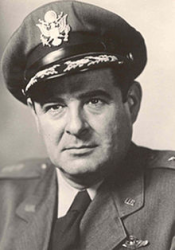
 |
|
|
||
|
Edwin William Rawlings |
||||
|
Engagements: • World War II (1941 - 1945) |
||||
| Biography: | ||||
|
Edwin William Rawlings Edwin William Rawlings was born on 11 September 1904 in Milroy, MN. In 1927, he graduated with a Bachelor's degree in Economics from Hamline University in Saint Paul, MN. For two years he worked as a reporter for the Pioneer Press and Dispatch in St. Paul and, in 1927, he became an Assistant Department Manager at the Dayton Company in Minneapolis. He was appointed a flying cadet in the U.S. Army Air Corps in February 1929 and commissioned a Second Lieutenant in the Air Corps of the Officer's Reserve a year later. On 8 May 1930, Rawlings was commissioned as a Second Lieutenant in the Air Corps of the Regular Army. Assigned to Luke Field, HI, as Assistant Photographic Officer, he later served as Commanding Officer of the 11th Photographic Section and Squadron Mess Officer of the Fourth Observation Squadron. While serving with the 18th Composite Wing in December 1931, he was placed in charge of construction of the Fort Shafter Flying Field in Hawaii. Rawlings went to Brooks Field, TX, in May 1932 and during three years at that station served as Adjutant and Assistant Operations Officer; Assistant Post and Group Adjutant; and Engineering and Armament Officer for the 12th Observation Group. He was promoted to Captain on 20 April 1935. In January 1945, Rawlings was promoted to Brigadier General. In August, he left on a Far East assignment, but the surrender of Japan brought him back to Wright-Patterson one month later. At this time he assumed responsibilities at Air Technical Service Command as Chief of the Procurement Division. In 1945, Air Force Secretary Stuart Symington asked Eugene M. Zuckert, Assistant Secretary of the Air Force, why he had to "send out a search party" whenever he needed Army Air Forces statistics. Zuckert (who later served as Secretary of the Air Force from 1961-65) remembered a memo (from Rawlings) suggesting the creation of a comptroller position and he passed the idea on to Symington. In July 1946, Rawlings was assigned to Air Force Headquarters in Washington to help organize the new office of Comptroller of the Air Force and, in November, Symington named Rawlings as Air Comptroller. Rawlings' efforts brought budgetary, fiscal and statistical functions together into a smooth-working organization. Rawlings guided the new office of comptroller through its formative years, 1946-51. In February 1947, Rawlings was promoted to Major General. Rawlings was promoted to the four-star rank of General on 19 February 1954 at age 49. In 1956, Rawlings headed a board that reviewed the Air Force's educational program. The board recommended to the Chief of Staff that additional incentives be given officers attending scientific courses, including preference in promotion. It also advised that Air University receive more funds to expand its educational program and to construct new facilities at the Air Force Institute of Technology Resident College. Although there had been recommendations in 1949-1950 that the Resident College be converted into a graduate school, leaving undergraduate study to civilian schools, the Rawlings Board advised that the need for undergraduate courses in science and engineering remained great. Many officers still lacked bachelor degrees and enough background to do graduate work. The board advised that both undergraduate and graduate studies be continued by the Air Force. General Rawlings retired from active duty on 28 February 1959. Medals and Awards Distinguished Service Medal 1 Awarded in 1930 for his role in the rescue of an aircrew downed in the Pacific. Rawlings was a Command Pilot who loved to fly; he was also a Combat and Aircraft Observer. Honors • In 1957, Rawlings received an award for outstanding contribution to aviation progress, the General William E. Mitchell Award. • In 1958 he received the Air Force Association's Citation of Honor. • He has received five honorary degrees. Ongoing Mentorships After retiring from the Air Force, Rawlings went on to a career with General Mills, rising to become President and board Chairman. During his second career, General Rawlings introduced corporate social responsibility and adapted the Delphi method for corporate strategic planning. Based in St. Paul, the Air Force Association's Gen. E. W. Rawlings Chapter was chartered in August 1982. Also in his name, AFA and AEF in 1981 established the Gen. Edwin W. Rawlings Award initially to recognize energy conservation achievements within USAF. Now the award recognizes an outstanding technician or manager in environmental matters. Death and Burial General Edwin William Rawlings died on 8 December 1997 in Auburn, WA, at age 93. He is buried at the United States Air Force Academy Cemetery in Colorado Springs, CO. His grave marker contains the words, "Born to Fly." |
||||
| Honoree ID: 818 | Created by: MHOH | |||
Ribbons
Medals
Badges
Honoree Photos
 |  |  |
 |  |
 |


